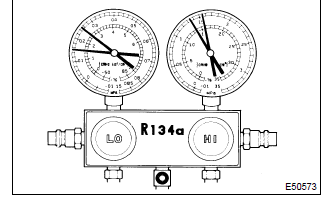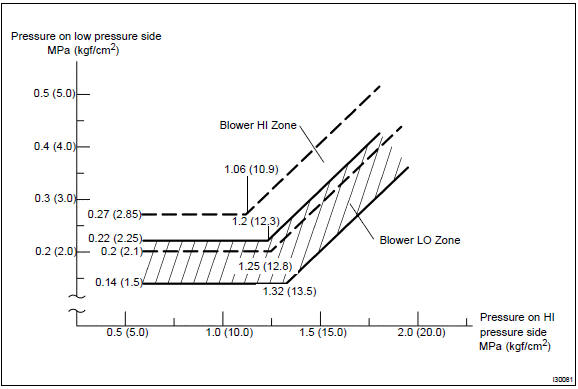Toyota Corolla (E120) 2002–2008 Repair Manual / Heater & air conditioner / Refrigerant / On–vehicle inspection
Toyota Corolla (E120): On–vehicle inspection
1. Inspect refrigerant pressure with manifold gauge set
- this is a method in witch the trouble is located by using
a manifold gauge set. Read the manifold gauge pressure
when the these conditions are established.
Test conditions:
- temperature at the air inlet with the switch set at recirc is 30 – 35 °c (86 – 95 °f)
- engine running at 1500 rpm
- blower speed control switch at ”hi” position
- temperature control dial at ”cool” position a/c switch on
- fully open doors

- Normally functioning refrigeration system.
Gauge reading:
low pressure side:
0.15 – 0.25 Mpa (1.5 – 2.5 Kgf/cm2) high pressure side:
1.37 – 1.57 Mpa (14 – 16 kgf/cm2)
- Moisture present in refrigeration system.

|
Symptom |
Probable cause |
Diagnosis |
Remedy |
| During operation, pressure on low pressure side sometimes become a vacuum and sometime normal | Moisture in refrigerating system freezes at expansion valve orifice causing a temporary stop of cycle, however, when it melts, normal state is restored. |
|
|
- Insufficient cooling

|
Symptom |
Probable cause |
Diagnosis |
Corrective actions |
|
Gas leakage in refrigeration system |
|
|
- Poor circulation of refrigerant

|
Symptom |
Probable cause |
Diagnosis |
Corrective actions |
|
Refrigerant flow obstructed by dirt in receiver | Receiver clogged | Replace condenser |
- Refrigerant does not circulate

|
Symptom |
Probable cause |
Diagnosis |
Corrective actions |
|
|
Refrigerant does not circulate |
|
- Refrigerant overcharged or insufficient cooling of condenser

|
Symptom |
Probable cause |
Diagnosis |
Corrective actions |
|
|
|
|
- Air present in refrigeration system

|
Symptom |
Probable cause |
Diagnosis |
Corrective actions |
|
Air entered in refrigerating system |
|
|
- Expansion valve improperly

|
Symptom |
Probable cause |
Diagnosis |
Corrective actions |
|
Trouble in expansion valve |
|
Check expansion valve |
- Defective compression compressor

|
Symptom |
Probable cause |
Diagnosis |
Corrective actions |
|
Internal leak in compressor |
|
Repair or replace compressor |
Gauge readings (reference)

Other materials:
Wiring diagram
1 Inspect terminal voltage(pi)
(a) turn
Turn the ignition switch to on.
measure voltage between terminal 5 (pi) of cruise control
ecu assy and body ground, when the cruise control main
switch button is on and off.
Ok:
2 Inspect combination meter assy
3 Check harn ...
When using a child
restraint system
■ When installing a child
restraint system to a front
passenger seat
For the safety of a child, install a
child restraint system to a rear
seat. When installing a child
restraint system to a front passenger
seat is unavoidable,
adjust the seat as follows and
install the child restraint system:
M ...
Toyota Safety Sense 3.0 software
update
It is necessary to enter a
connected services contract,
provided by Toyota, to
use these functions. For
details, contact your Toyota
dealer.
WARNING
■For safe use
When the Toyota Safety Sense
3.0 software is updated, the operating
methods of functions may
change. Using this system without
knowing ...


